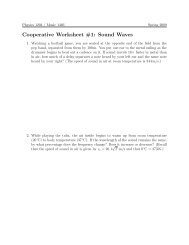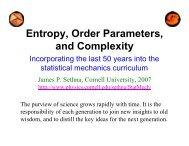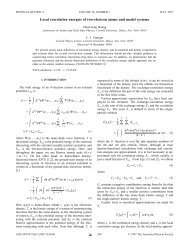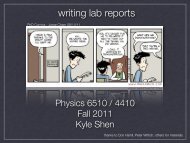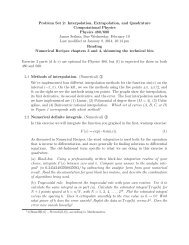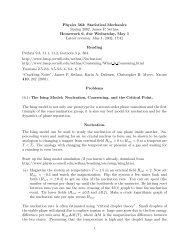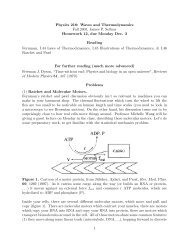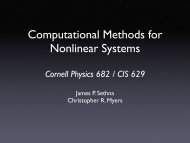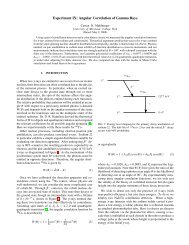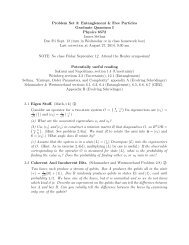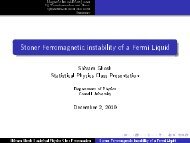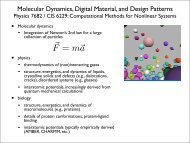4. Bosons, Fermions, and Anyons - Are you sure you want to look at ...
4. Bosons, Fermions, and Anyons - Are you sure you want to look at ...
4. Bosons, Fermions, and Anyons - Are you sure you want to look at ...
You also want an ePaper? Increase the reach of your titles
YUMPU automatically turns print PDFs into web optimized ePapers that Google loves.
′ j = r j for all but one of the particles <strong>and</strong> integr<strong>at</strong>ing over all possible positions,multiplying by N:̂ρ 2 (r ′ , r) =∫N d 3 r 2 · · · d 3 r N× ̂ρ(r ′ , r 2 . . . , r N , r, r 2 , . . . , r N ). (8)(For our purposes, the fact th<strong>at</strong> it is called a m<strong>at</strong>rix is not important; think of ̂ρ 2 as afunction of two variables.)(a) Wh<strong>at</strong> does the reduced density m<strong>at</strong>rix ρ 2 (r ′ , r) <strong>look</strong> like for a zero-temper<strong>at</strong>ure Bosecondens<strong>at</strong>e of non-interacting particles, condensed in<strong>to</strong> a normalized single-particlest<strong>at</strong>e ζ(r)? (Th<strong>at</strong> is, Ψ(r 1 , . . . , r N ) = ∏ Nm=1 ζ(r m).)An altern<strong>at</strong>ive, elegant formul<strong>at</strong>ion for this density m<strong>at</strong>rix is <strong>to</strong> use second-quantizedcre<strong>at</strong>ion <strong>and</strong> annihil<strong>at</strong>ion opera<strong>to</strong>rs instead of the many-body wavefunctions. Theseopera<strong>to</strong>rs a † (r) <strong>and</strong> a(r) add <strong>and</strong> remove a boson <strong>at</strong> a specific place in space. Theyobey the commut<strong>at</strong>ion rel<strong>at</strong>ions[a(r), a † (r ′ )] = δ(r − r ′ ),[a(r), a(r ′ )] = [a † (r), a † (r ′ )] = 0;(9)since the vacuum has no particles, we also knowa(r)|0〉 = 0,〈0|a † (r) = 0.(10)We define the ket wavefunction as|Ψ〉 = (1/ √ ∫N!)d 3 r 1 · · · d 3 r N× Ψ(r 1 , . . . , r N )a † (r 1 ) . . . a † (r N )|0〉. (11)(b) Show th<strong>at</strong> the ket is normalized if the symmetric Bose wavefunction Ψ is normalized.(Hint: Use eqn 9 <strong>to</strong> pull the as <strong>to</strong> the right through the a † s in eqn 11; <strong>you</strong> shouldget a sum of N! terms, each a product of N δ-functions, setting different permut<strong>at</strong>ionsof r 1 · · · r N equal <strong>to</strong> r ′ 1 · · · r ′ N .) Show th<strong>at</strong> 〈Ψ|a† (r ′ )a(r)|Ψ〉, the overlap of a(r)|Ψ〉 witha(r ′ )|Ψ〉 for the pure st<strong>at</strong>e |Ψ〉 gives the the reduced density m<strong>at</strong>rix 8.Since this is true of all pure st<strong>at</strong>es, it is true of mixtures of pure st<strong>at</strong>es as well; hencethe reduced density m<strong>at</strong>rix is the same as the expect<strong>at</strong>ion value 〈a † (r ′ )a(r)〉.In a non-degener<strong>at</strong>e Bose gas, in a system with Maxwell–Boltzmann st<strong>at</strong>istics, or ina Fermi system, one can calcul<strong>at</strong>e ̂ρ 2 (r ′ , r) <strong>and</strong> show th<strong>at</strong> it rapidly goes <strong>to</strong> zero as



